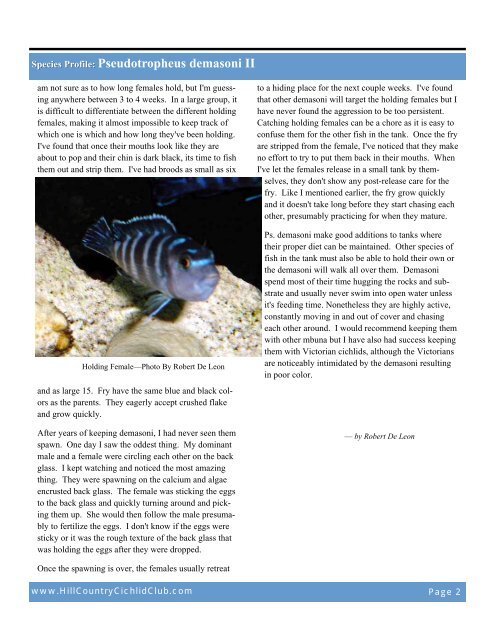Pseudotropheus demasoni 2.pub - Hill Country Cichlid Club
Pseudotropheus demasoni 2.pub - Hill Country Cichlid Club Pseudotropheus demasoni 2.pub - Hill Country Cichlid Club
Species Profile: Pseudotropheus demasoni IIam not sure as to how long females hold, but I'm guessinganywhere between 3 to 4 weeks. In a large group, itis difficult to differentiate between the different holdingfemales, making it almost impossible to keep track ofwhich one is which and how long they've been holding.I've found that once their mouths look like they areabout to pop and their chin is dark black, its time to fishthem out and strip them. I've had broods as small as sixHolding Female—Photo By Robert De Leonand as large 15. Fry have the same blue and black colorsas the parents. They eagerly accept crushed flakeand grow quickly.After years of keeping demasoni, I had never seen themspawn. One day I saw the oddest thing. My dominantmale and a female were circling each other on the backglass. I kept watching and noticed the most amazingthing. They were spawning on the calcium and algaeencrusted back glass. The female was sticking the eggsto the back glass and quickly turning around and pickingthem up. She would then follow the male presumablyto fertilize the eggs. I don't know if the eggs weresticky or it was the rough texture of the back glass thatwas holding the eggs after they were dropped.to a hiding place for the next couple weeks. I've foundthat other demasoni will target the holding females but Ihave never found the aggression to be too persistent.Catching holding females can be a chore as it is easy toconfuse them for the other fish in the tank. Once the fryare stripped from the female, I've noticed that they makeno effort to try to put them back in their mouths. WhenI've let the females release in a small tank by themselves,they don't show any post-release care for thefry. Like I mentioned earlier, the fry grow quicklyand it doesn't take long before they start chasing eachother, presumably practicing for when they mature.Ps. demasoni make good additions to tanks wheretheir proper diet can be maintained. Other species offish in the tank must also be able to hold their own orthe demasoni will walk all over them. Demasonispend most of their time hugging the rocks and substrateand usually never swim into open water unlessit's feeding time. Nonetheless they are highly active,constantly moving in and out of cover and chasingeach other around. I would recommend keeping themwith other mbuna but I have also had success keepingthem with Victorian cichlids, although the Victoriansare noticeably intimidated by the demasoni resultingin poor color.— by Robert De LeonOnce the spawning is over, the females usually retreatwww.HillCountryCichlidClub.com Page 2
Species Profile: <strong>Pseudotropheus</strong> <strong>demasoni</strong> IIam not sure as to how long females hold, but I'm guessinganywhere between 3 to 4 weeks. In a large group, itis difficult to differentiate between the different holdingfemales, making it almost impossible to keep track ofwhich one is which and how long they've been holding.I've found that once their mouths look like they areabout to pop and their chin is dark black, its time to fishthem out and strip them. I've had broods as small as sixHolding Female—Photo By Robert De Leonand as large 15. Fry have the same blue and black colorsas the parents. They eagerly accept crushed flakeand grow quickly.After years of keeping <strong>demasoni</strong>, I had never seen themspawn. One day I saw the oddest thing. My dominantmale and a female were circling each other on the backglass. I kept watching and noticed the most amazingthing. They were spawning on the calcium and algaeencrusted back glass. The female was sticking the eggsto the back glass and quickly turning around and pickingthem up. She would then follow the male presumablyto fertilize the eggs. I don't know if the eggs weresticky or it was the rough texture of the back glass thatwas holding the eggs after they were dropped.to a hiding place for the next couple weeks. I've foundthat other <strong>demasoni</strong> will target the holding females but Ihave never found the aggression to be too persistent.Catching holding females can be a chore as it is easy toconfuse them for the other fish in the tank. Once the fryare stripped from the female, I've noticed that they makeno effort to try to put them back in their mouths. WhenI've let the females release in a small tank by themselves,they don't show any post-release care for thefry. Like I mentioned earlier, the fry grow quicklyand it doesn't take long before they start chasing eachother, presumably practicing for when they mature.Ps. <strong>demasoni</strong> make good additions to tanks wheretheir proper diet can be maintained. Other species offish in the tank must also be able to hold their own orthe <strong>demasoni</strong> will walk all over them. Demasonispend most of their time hugging the rocks and substrateand usually never swim into open water unlessit's feeding time. Nonetheless they are highly active,constantly moving in and out of cover and chasingeach other around. I would recommend keeping themwith other mbuna but I have also had success keepingthem with Victorian cichlids, although the Victoriansare noticeably intimidated by the <strong>demasoni</strong> resultingin poor color.— by Robert De LeonOnce the spawning is over, the females usually retreatwww.<strong>Hill</strong><strong>Country</strong><strong>Cichlid</strong><strong>Club</strong>.com Page 2



